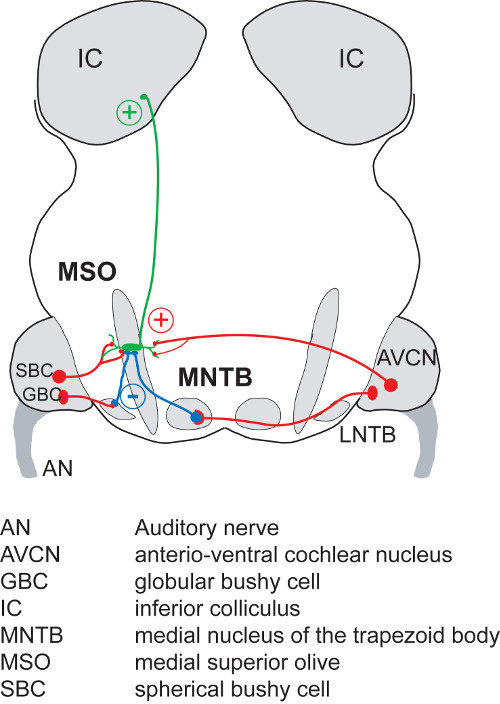Project C-T2 - Coding of interaural time differences in electrically evoked responses
Bilateral cochlear implants (CI) offer patients the benefits of the
binaural auditory system in everyday life. Thus the number of
patients with bilateral cochlear implants (CI) is steadily
increasing. However the use of interaul time delays (ITDs) is still
severely limited in patients with bilateral CIs. ITD is one of the
most crucial binaural cues for sound localization and speech
comprehension.
Important progress in animal models of
bilateral CIs has been achieved. These models illustrate neuronal
sensitivity to binaural electrical stimulation and the role of
acoustic deprivation for ITD discrimination with CIs. Though the
reason for the deficit of bilateral CIs in ITD processing remains
unknown. For instance, the use of a binaural jitter enhances the ITD
sensitivity and increasing stimulation rates decreases the ITD
sensitivity. Besides, the neuronal mechanism and the cue sensitivity
underlying the processing of interaural time delays is so far not
completely understood and still evolving.
Objective and description of the project
 We will investigate under which conditions the decoding
of ITDs for electrical hearing is possible. Extracellular recordings
from responses of auditory midbrain neurons (IC) will be obtained. In
particular, neuronal responses to binaural electrical stimulation with
microsecond interaural time differences will be recorded and compared to
acoustically evoked responses in normal hearing creatures.
We will investigate under which conditions the decoding
of ITDs for electrical hearing is possible. Extracellular recordings
from responses of auditory midbrain neurons (IC) will be obtained. In
particular, neuronal responses to binaural electrical stimulation with
microsecond interaural time differences will be recorded and compared to
acoustically evoked responses in normal hearing creatures.
Models will help us to understand why ITD sensivity degrades with increasing puls-rates of electrical stimulation and they will help us to find coding strategies to optimize ITD sensivity. Furthermore the modeling studies will systematically investigate the mechanism of ITD processing and differences between acoustic and electric ITD sensitivity. Predictions deriving from these models will contribute to our physiological recordings and will be experimentally tested. Our findings will be crucial in the development of a new generation of bilateral CIs allowing the use of ITD cues by the listeners.
References
Smith ZM, Delgutte B. (2007)
Sensitivity to interaural time differences in the inferior
colliculus with bilateral cochlear implants.
J Neurosci, 27(25): 6740-50.
Smith ZM, Delgutte B. (2008)
Sensitivity of inferior colliculus neurons to interaural time
differences in the envelope versus the fine structure with bilateral
cochlear implants. J Neurophysiol, (5): 2390-407.
Hancock KE, Noel V, Ryugo DK,
Delgutte B. (2010)
Neural coding of interaural time differences with bilateral
cochlear implants: effects of congenital deafness. J Neurosci, 30(42): 14068-79.
Laback B, Majdak P. (2008)
Binaural jitter improves interaural time-difference sensitivity of
cochlear implantees at high pulse rates. Proc Natl Acad Sci U S A, 105(2): 814-7.
Grothe B, Pecka M,
McAlpine D. (2010)
Mechanisms of sound localization in mammals.
Physiol Rev, 90(3): 983-1012.

